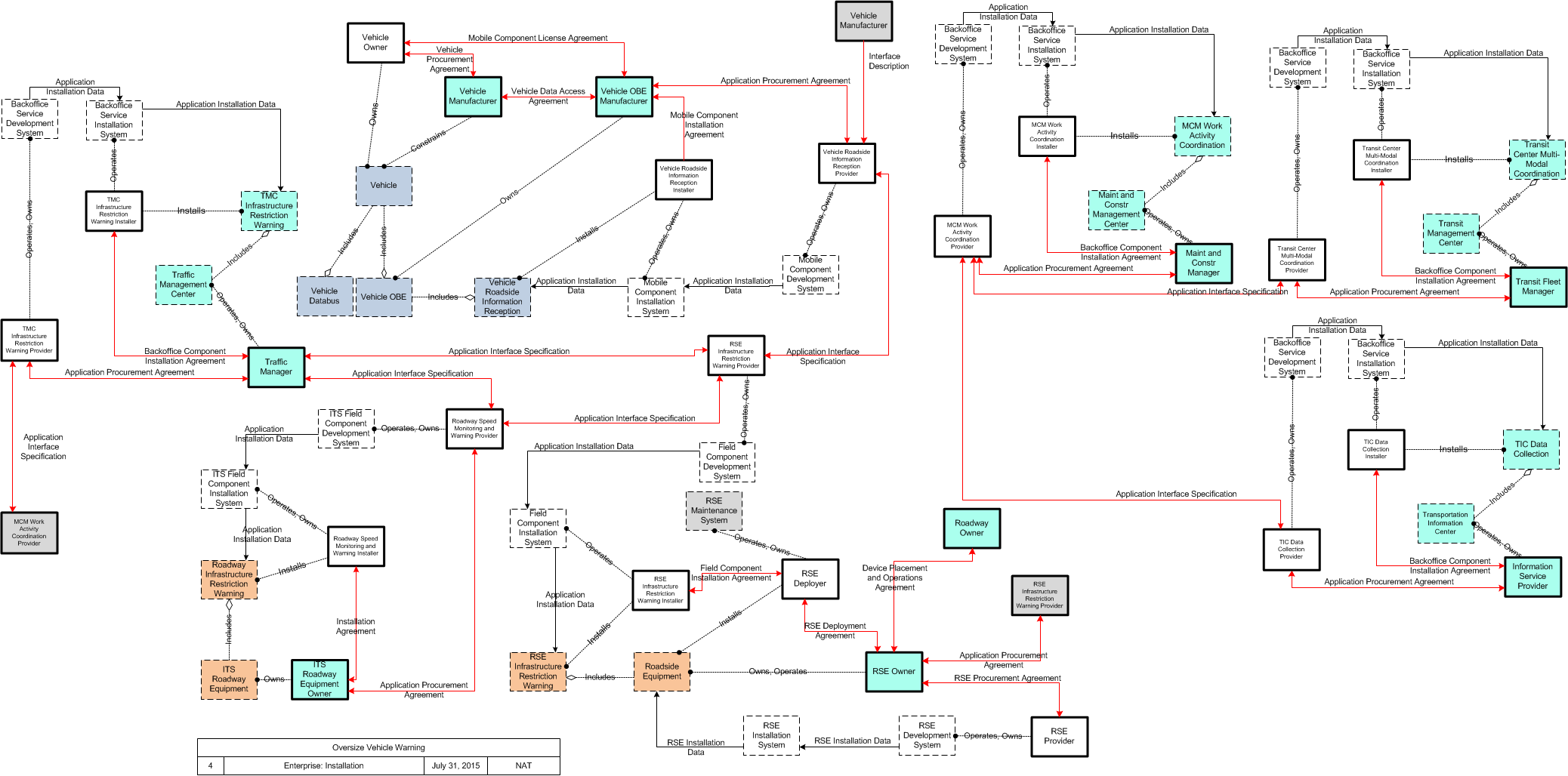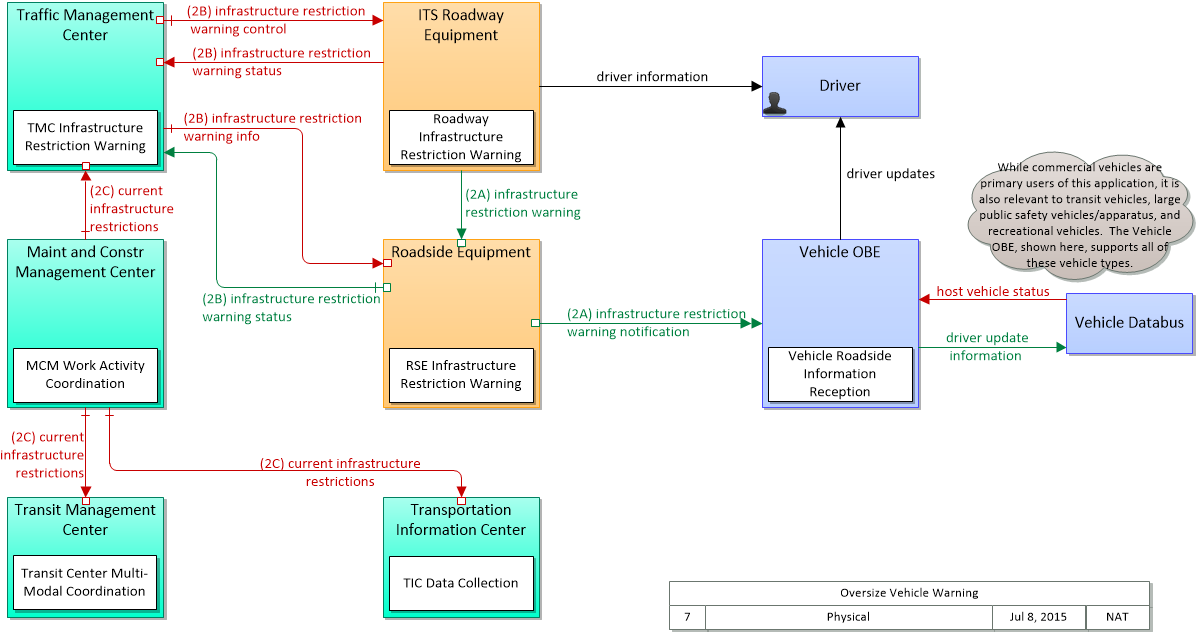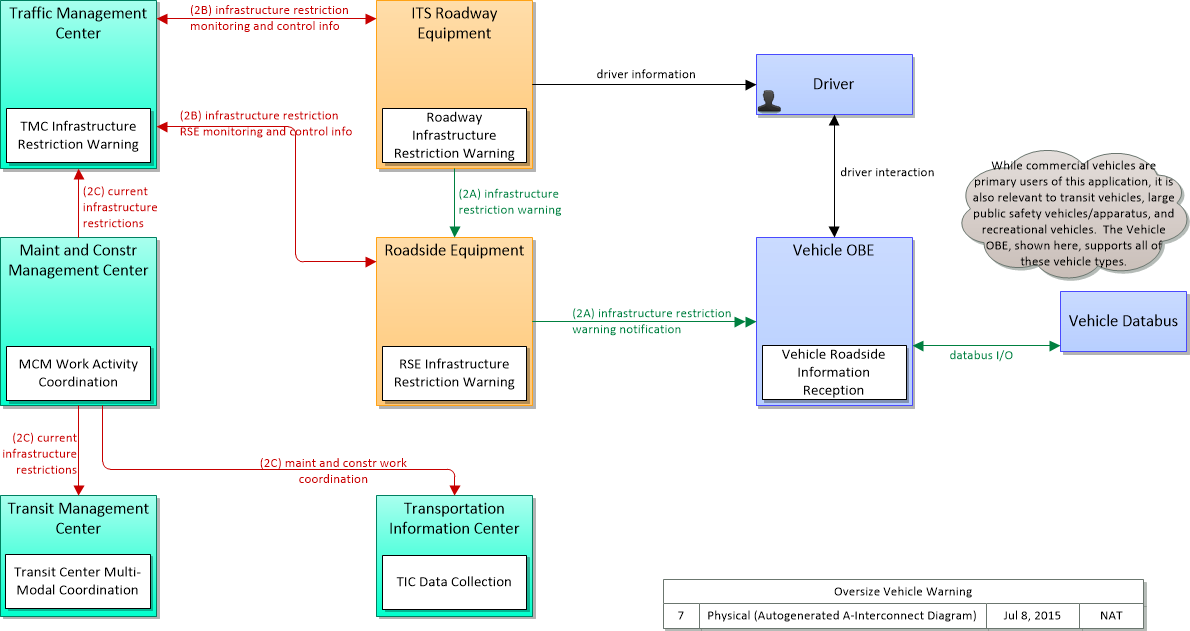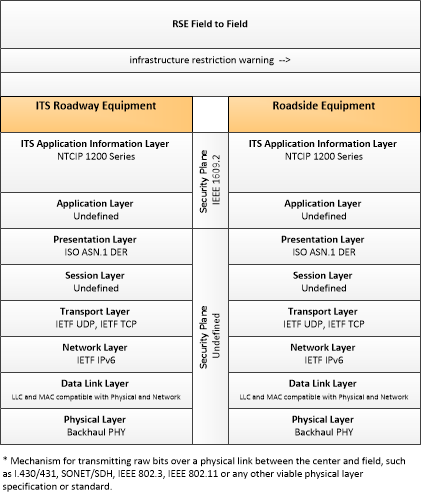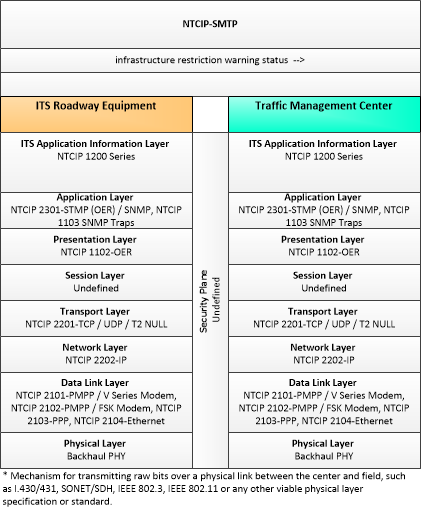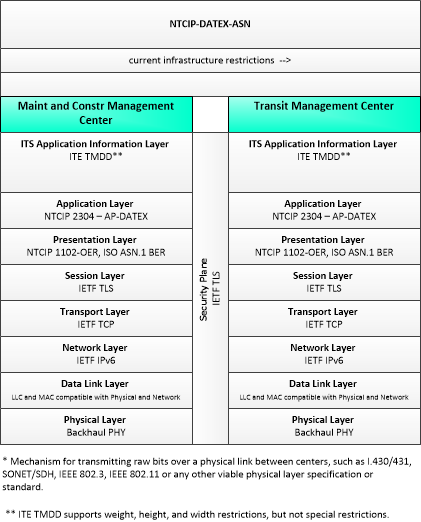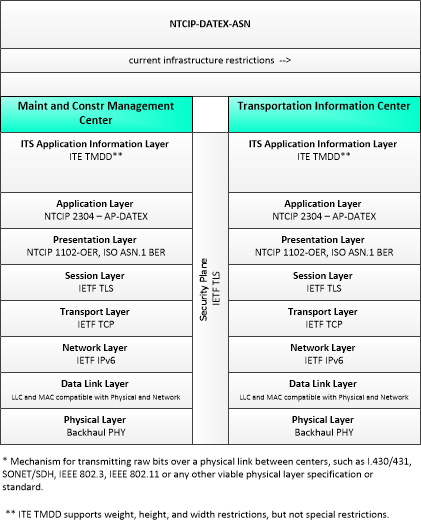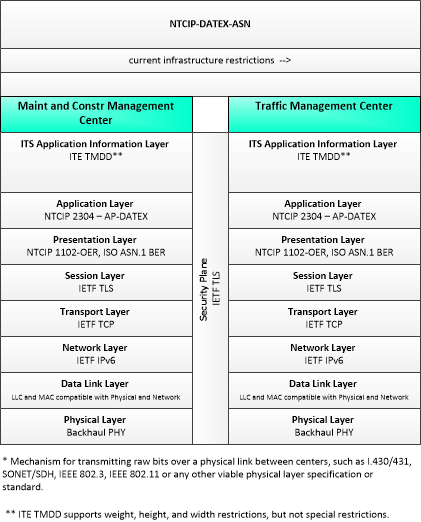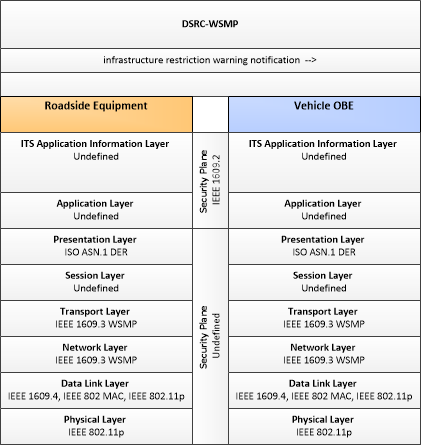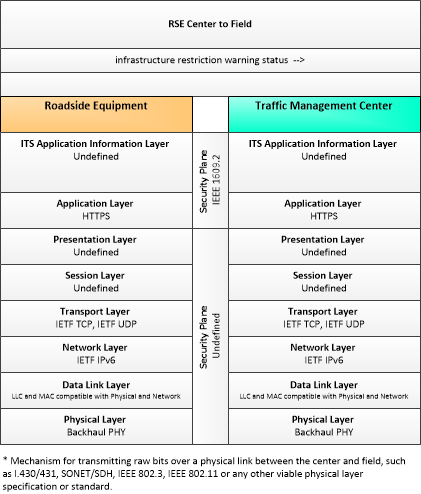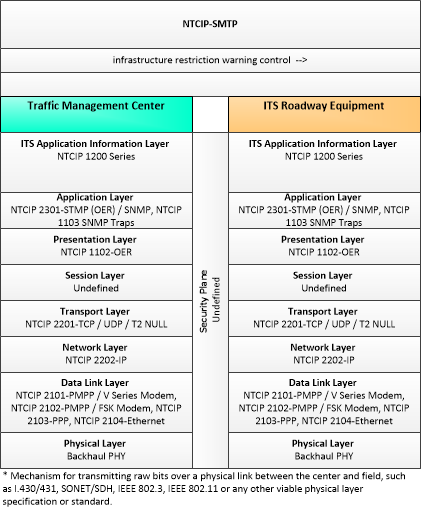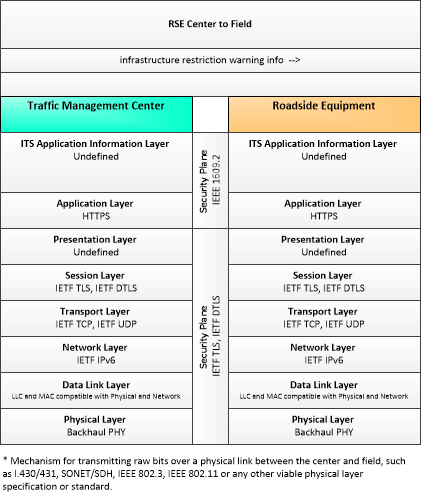Type: Safety
Groups:- V2I Safety
Oversize Vehicle Warning
The Oversize Vehicle Warning (OVW) application uses external measurements taken by the roadside infrastructure, and transmitted to the vehicle, to support in-vehicle determination of whether an alert/warning is necessary. Specifically, the infrastructure data equipment detects and measures the approaching vehicle's height and width. The infrastructure component of the application transmits the vehicle measurements, along with bridge, overpass, or tunnel geometry, to the OVW vehicle application. The vehicle application utilizes these data to determine whether the vehicle can clear the bridge or tunnel. If deemed necessary, the driver is alerted to the impending low height and/or narrow horizontal clearance bridge or tunnel prior to a decision point, enabling the vehicle to reroute and avoid a collision. If the vehicle driver ignores the alert and continues along the route, the vehicle will generate a warning indicating an impending collision at a point near the bridge or tunnel approach. To support unequipped vehicles the infrastructure will display warning or reroute information when the measurements indicate that a vehicle does not have adequate height or width clearance. This application could be expanded to consider overweight as well as height and width.
Enterprise
SVG Diagrams: Installation Operations Maintenance Certification
PNG Diagrams: Installation Operations Maintenance Certification

Business Interaction Matrix:
| Oversize Vehicle Warning Operations Stage | ||||||||||||||
|---|---|---|---|---|---|---|---|---|---|---|---|---|---|---|
| Vehicle Owner | Driver | Vehicle OBE Owner | Roadway Owner | RSE Owner | RSE Operator | ITS Roadway Equipment Owner | ITS Roadway Operator | Traffic Manager | Information Service Provider | Maint and Constr Manager | RSE Infrastructure Restriction Warning Provider | Transit Fleet Manager | Vehicle Roadside Information Reception Provider | |
| Vehicle Owner | Vehicle Usage Agreement | Vehicle OBE Usage Agreement | Application Usage Agreement | |||||||||||
| Driver | Vehicle Usage Agreement | Expectation of Information Provision | Expectation of Information Provision | |||||||||||
| Vehicle OBE Owner | Vehicle OBE Usage Agreement | Expectation of Information Provision | Expectation of Information Provision | |||||||||||
| Roadway Owner | Service Delivery Agreement | |||||||||||||
| RSE Owner | Expectation of Information Provision | Service Delivery Agreement | Operations Agreement | Information Provision Agreement | Information Exchange Agreement | Application Usage Agreement | ||||||||
| RSE Operator | Operations Agreement | |||||||||||||
| ITS Roadway Equipment Owner | Information Provision Agreement | Operations Agreement | Information Exchange Agreement | |||||||||||
| ITS Roadway Operator | Expectation of Information Provision | Operations Agreement | ||||||||||||
| Traffic Manager | Information Exchange Agreement | Information Exchange Agreement | Information Provision Agreement | |||||||||||
| Information Service Provider | Information Provision Agreement | |||||||||||||
| Maint and Constr Manager | Information Provision Agreement | Information Provision Agreement | Information Provision Agreement | |||||||||||
| RSE Infrastructure Restriction Warning Provider | Application Usage Agreement | |||||||||||||
| Transit Fleet Manager | Information Provision Agreement | |||||||||||||
| Vehicle Roadside Information Reception Provider | Application Usage Agreement | |||||||||||||
Includes Enterprise Objects:
| Enterprise Object | Description |
|---|---|
| Application Certification Entity | The body that determines whether an application may be deployed and operated in the Connected Vehicle Environment. This entity's composition, the requirements it applies and the procedures it uses to verify those requirements may vary with application type. For example, applications with human safety component (crash avoidance, movement assistance etc.) may have stringent requirements and extensive testing in a variety of conditions, while applications that provide strictly mobility functionality may have far less testing requirements; possibly as little as just making sure the application doesn't interfere with any other applications. |
| Commercial Vehicle Manufacturer | The entity which builds commercial vehicles, including long haul trucks and local pick up and delivery vehicles. This entity is complementary to the Vehicle Manufacturer entity in that it represents those aspects of vehicle manufacture which are unique to commercial vehicles. |
| Device Certification Entity | The body that determines whether a device may be deployed and operated in the Connected Vehicle Environment. This entity's composition, the requirements it applies and the procedures it uses to verify those requirements may vary with device type. |
| Driver | The 'Driver' represents the person that operates a vehicle on the roadway. Included are operators of private, transit, commercial, and emergency vehicles where the interactions are not particular to the type of vehicle (e.g., interactions supporting vehicle safety applications). The Driver originates driver requests and receives driver information that reflects the interactions which might be useful to all drivers, regardless of vehicle classification. Information and interactions which are unique to drivers of a specific vehicle type (e.g., fleet interactions with transit, commercial, or emergency vehicle drivers) are covered by separate objects. |
| Federal Regulatory | Federal regulatory bodies that have legal authority to control and/or provide input to policies regulating transportation infrastructure and operations. This includes entities such as the Federal Communications Commission and US Department of Transportation. |
| Information Service Provider | The "Information Service Provider" represents the owner of the Transportation Information Center. The Information Service Provider is responsible for collecting and disseminating information relevant to the traveling public. |
| ITS Certification Entity | The body that determines whether an ITS device or application may be deployed and operated in the transportation environment. This entity's composition, the requirements it applies and the procedures it uses to verify those requirements may vary with device and application type. Typically not a formal body, assigned on a project-by-project basis depending on the type of infrastructure involved. Since ITS projects are locally-focused (typically state or smaller), the entities that are part of this body are typically those with operational jurisdiction where the ITS is installed (e.g., state or local DOTs, state or local maintenance managers etc.) |
| ITS Roadway Equipment Owner | The entity that owns the Roadway ITS equipment. |
| ITS Roadway Operator | The entity that operates the Roadway ITS equipment. |
| Maint and Constr Manager | The organization responsible for maintenance and construction activities. |
| MCM Work Activity Coordination Installer | Application Component Installers are specified more by role than by function. Installers are responsible for the installation of the application component, which may require a support system, and may entail agreements and relationships between end users and application providers. |
| MCM Work Activity Coordination Maintainer | Application Component Maintainers are specified more by role than by function. Maintainers are responsible for the maintenance (configuration changes, patches and updates, hardware repairs) of the application component, which may require a support system, and may entail agreements and relationships between end users and application providers. |
| MCM Work Activity Coordination Provider | Application Component Providers are specified more by role than by function. Providers are responsible for the development of the application component, including initial creation, enhancement and bug fixes. Delivery of the application to the end user may require relationships with other entities (installers, maintainers) if the provider chooses not to fulfill those roles. |
| Roadway Owner | The owner of the roadway proximate to which roadside equipment will be/is installed. |
| Roadway Speed Monitoring and Warning Installer | Application Component Installers are specified more by role than by function. Installers are responsible for the installation of the application component, which may require a support system, and may entail agreements and relationships between end users and application providers. |
| Roadway Speed Monitoring and Warning Maintainer | Application Component Maintainers are specified more by role than by function. Maintainers are responsible for the maintenance (configuration changes, patches and updates, hardware repairs) of the application component, which may require a support system, and may entail agreements and relationships between end users and application providers. |
| Roadway Speed Monitoring and Warning Provider | Application Component Providers are specified more by role than by function. Providers are responsible for the development of the application component, including initial creation, enhancement and bug fixes. Delivery of the application to the end user may require relationships with other entities (installers, maintainers) if the provider chooses not to fulfill those roles. |
| RSE Deployer | The entity responsible for the deployment, operations and maintenance of roadside equipment. |
| RSE Infrastructure Restriction Warning Installer | Application Component Installers are specified more by role than by function. Installers are responsible for the installation of the application component, which may require a support system, and may entail agreements and relationships between end users and application providers. |
| RSE Infrastructure Restriction Warning Maintainer | Application Component Maintainers are specified more by role than by function. Maintainers are responsible for the maintenance (configuration changes, patches and updates, hardware repairs) of the application component, which may require a support system, and may entail agreements and relationships between end users and application providers. |
| RSE Infrastructure Restriction Warning Provider | Application Component Providers are specified more by role than by function. Providers are responsible for the development of the application component, including initial creation, enhancement and bug fixes. Delivery of the application to the end user may require relationships with other entities (installers, maintainers) if the provider chooses not to fulfill those roles. |
| RSE Maintainer | The entity that maintains the roadside equipment, including its hardware and operating system software, but not applications software. |
| RSE Operator | The entity that operates roadside equipment in the transportation environment. |
| RSE Owner | The owner of roadside equipment. |
| RSE Provider | The "RSE Provider" is the entity that develops and (presumably) sells roadside equipment to other entities for deployment and research. |
| State Regulatory | State regulatory bodies that have legal authority to control and/or provide input to policies regulating vehicles, transportation infrastructure and operations. This includes entities like Departments of Motor Vehicles, property tax authorities and tolling agencies. |
| TIC Data Collection Installer | Application Component Installers are specified more by role than by function. Installers are responsible for the installation of the application component, which may require a support system, and may entail agreements and relationships between end users and application providers. |
| TIC Data Collection Maintainer | Application Component Maintainers are specified more by role than by function. Maintainers are responsible for the maintenance (configuration changes, patches and updates, hardware repairs) of the application component, which may require a support system, and may entail agreements and relationships between end users and application providers. |
| TIC Data Collection Provider | Application Component Providers are specified more by role than by function. Providers are responsible for the development of the application component, including initial creation, enhancement and bug fixes. Delivery of the application to the end user may require relationships with other entities (installers, maintainers) if the provider chooses not to fulfill those roles. |
| TMC Infrastructure Restriction Warning Installer | Application Component Installers are specified more by role than by function. Installers are responsible for the installation of the application component, which may require a support system, and may entail agreements and relationships between end users and application providers. |
| TMC Infrastructure Restriction Warning Maintainer | Application Component Maintainers are specified more by role than by function. Maintainers are responsible for the maintenance (configuration changes, patches and updates, hardware repairs) of the application component, which may require a support system, and may entail agreements and relationships between end users and application providers. |
| TMC Infrastructure Restriction Warning Provider | Application Component Providers are specified more by role than by function. Providers are responsible for the development of the application component, including initial creation, enhancement and bug fixes. Delivery of the application to the end user may require relationships with other entities (installers, maintainers) if the provider chooses not to fulfill those roles. |
| Traffic Manager | The entity responsible for the management of traffic, both freeway and arterial. |
| Transit Center Multi-Modal Coordination Installer | Application Component Installers are specified more by role than by function. Installers are responsible for the installation of the application component, which may require a support system, and may entail agreements and relationships between end users and application providers. |
| Transit Center Multi-Modal Coordination Maintainer | Application Component Maintainers are specified more by role than by function. Maintainers are responsible for the maintenance (configuration changes, patches and updates, hardware repairs) of the application component, which may require a support system, and may entail agreements and relationships between end users and application providers. |
| Transit Center Multi-Modal Coordination Provider | Application Component Providers are specified more by role than by function. Providers are responsible for the development of the application component, including initial creation, enhancement and bug fixes. Delivery of the application to the end user may require relationships with other entities (installers, maintainers) if the provider chooses not to fulfill those roles. |
| Transit Fleet Manager | The agency or organization that operates transit vehicles. This includes administration, routing, driver instruction, maintenance and any other responsibilities associated with the operations and maintenance of a transit system. |
| Vehicle Manufacturer | The entity that builds, assembles, verifies and validates the Vehicle in which the Vehicle OBE will eventually operate. |
| Vehicle OBE Manufacturer | The entity that builds, assembles, verifies and validates the Vehicle OBE. This can be an OEM-equipped OBE, retrofit or aftermarket equipment. |
| Vehicle OBE Owner | The entity, individual, group or corporation that owns the Vehicle On-Board equipment. This could be the same as the Vehicle Owner, but it could be a third part that licenses the use of the OBE to the Owner. |
| Vehicle Owner | The individual, group of individuals or corporate entity that is identified as the registered owner of the Vehicle under state law. |
| Vehicle Roadside Information Reception Installer | Application Component Installers are specified more by role than by function. Installers are responsible for the installation of the application component, which may require a support system, and may entail agreements and relationships between end users and application providers. |
| Vehicle Roadside Information Reception Maintainer | Application Component Maintainers are specified more by role than by function. Maintainers are responsible for the maintenance (configuration changes, patches and updates, hardware repairs) of the application component, which may require a support system, and may entail agreements and relationships between end users and application providers. |
| Vehicle Roadside Information Reception Provider | Application Component Providers are specified more by role than by function. Providers are responsible for the development of the application component, including initial creation, enhancement and bug fixes. Delivery of the application to the end user may require relationships with other entities (installers, maintainers) if the provider chooses not to fulfill those roles. |
Includes Resources:
| Resource | Description |
|---|---|
| Application Component Certification Requirements | The requirements that define the functionality, performance and operational environment of an application component. Certification Requirements must be met in order for an application to be installed in the CVE. |
| Backoffice Service Development System | The systems used to develop backoffice (center) hardware and software components of applications. |
| Backoffice Service Installation System | The systems used to install and configure backoffice (center) hardware and software components. |
| Backoffice Service Maintenance System | The systems used to maintain and upgrade backoffice (center) hardware and software components. |
| Commercial Vehicle OBE | The Commercial Vehicle On-Board Equipment (OBE) resides in a commercial vehicle and provides the sensory, processing, storage, and communications functions necessary to support safe and efficient commercial vehicle operations. It provides two-way communications between the commercial vehicle drivers, their fleet managers, attached freight equipment, and roadside officials. In CVRIA, a separate 'Vehicle OBE' physical object supports the general V2V and V2I safety applications and other applications that apply to all vehicles, including commercial vehicles. The Commercial Vehicle OBE supplements these general capabilities with capabilities that are specific to commercial vehicles. |
| Device Certification Requirements | The requirements that define the functionality, performance and operational environment of a connected vehicle device. Certification Requirements must be met in order for the device to be granted the credentials necessary to operate in the Connected Vehicle Environment. |
| Field Component Development System | The system used in a backoffice environment to develop and test the field component of the application. |
| Field Component Installation System | The system used to install a field component of a connected vehicle application. |
| Field Component Maintenance System | The system used to install and configure changes and updates to the field component of the application. This system is capable of acquiring and reporting diagnostic information about the application's configuration and performance. |
| ITS Certification Requirements | The requirements that define the functionality, performance and operational environment of an ITS device or ITS application. Applicability varies with jurisdictions, but typically devices and applications must meet pre-defined acceptance criteria prior to usage in the transportation environment. |
| ITS Field Component Development System | The system used in a backoffice environment to develop and test the ITS field component of the application. |
| ITS Field Component Installation System | The system used to install a field component of a connected vehicle application. |
| ITS Field Component Maintenance System | The system used to install and configure changes and updates to the ITS field component of the application. This system is capable of acquiring and reporting diagnostic information about the application's configuration and performance. |
| ITS Roadway Equipment | 'ITS Roadway Equipment' represents the ITS equipment that is distributed on and along the roadway that monitors and controls traffic and monitors and manages the roadway itself. In CVRIA, this physical object represents all of the other ITS field equipment that interfaces with and supports the Connected Vehicle Roadside Equipment (RSE). This physical object includes traffic detectors, environmental sensors, traffic signals, highway advisory radios, dynamic message signs, CCTV cameras and video image processing systems, grade crossing warning systems, and ramp metering systems. Lane management systems and barrier systems that control access to transportation infrastructure such as roadways, bridges and tunnels are also included. This object also provides environmental monitoring including sensors that measure road conditions, surface weather, and vehicle emissions. Work zone systems including work zone surveillance, traffic control, driver warning, and work crew safety systems are also included. |
| Maint and Constr Management Center | The 'Maint and Constr Management Center' monitors and manages roadway infrastructure construction and maintenance activities. Representing both public agencies and private contractors that provide these functions, this physical object manages fleets of maintenance, construction, or special service vehicles (e.g., snow and ice control equipment). The physical object receives a wide range of status information from these vehicles and performs vehicle dispatch, routing, and resource management for the vehicle fleets and associated equipment. The physical object participates in incident response by deploying maintenance and construction resources to an incident scene, in coordination with other center physical objects. The physical object manages equipment at the roadside, including environmental sensors and automated systems that monitor and mitigate adverse road and surface weather conditions. It manages the repair and maintenance of both non-ITS and ITS equipment including the traffic controllers, detectors, dynamic message signs, signals, and other equipment associated with the roadway infrastructure. Weather information is collected and fused with other data sources and used to support advanced decision support systems. The physical object remotely monitors and manages ITS capabilities in work zones, gathering, storing, and disseminating work zone information to other systems. It manages traffic in the vicinity of the work zone and advises drivers of work zone status (either directly at the roadside or through an interface with the Transportation Information Center or Traffic Management Center physical objects.) Construction and maintenance activities are tracked and coordinated with other systems, improving the quality and accuracy of information available regarding closures and other roadway construction and maintenance activities. |
| MCM Work Activity Coordination | "MCM Work Activity Coordination" disseminates work activity schedules and current asset restrictions to other agencies. Work schedules are coordinated with operating agencies, factoring in the needs and activities of other agencies and adjacent jurisdictions. Work schedules are also distributed to Transportation Information Centers for dissemination to the traveling public. |
| Mobile Component Development System | The system used in a backoffice environment to develop and test the mobile component of the application. |
| Mobile Component Installation System | The system that interacts with the Vehicle OBE other mobile device and installs the mobile component of the application. |
| Mobile Component Maintenance System | The system used to configure changes and updates to the mobile component of the application. This system is capable of acquiring and reporting diagnostic information about the application's configuration and performance. |
| Roadside Equipment | 'Roadside Equipment' (RSE) represents the Connected Vehicle roadside devices that are used to send messages to, and receive messages from, nearby vehicles using Dedicated Short Range Communications (DSRC) or other alternative wireless communications technologies. Communications with adjacent field equipment and back office centers that monitor and control the RSE are also supported. This device operates from a fixed position and may be permanently deployed or a portable device that is located temporarily in the vicinity of a traffic incident, road construction, or a special event. It includes a processor, data storage, and communications capabilities that support secure communications with passing vehicles, other field equipment, and centers. |
| Roadway Infrastructure Restriction Warning | "Roadway Infrastructure Restriction Warning" measures the size of passing vehicles and displays warnings to vehicles if the size exceeds the current infrastructure restrictions. The measured vehicle dimensions are also made available to other applications. |
| RSE Development System | The system used in a backoffice environment to develop and test the roadside equipment. |
| RSE Infrastructure Restriction Warning | "RSE Infrastructure Restriction Warning" uses short range communications to warn vehicles of infrastructure dimensional and weight restrictions. |
| RSE Installation System | The system used to install and configure the roadside equipment. |
| RSE Maintenance System | The system used to configure changes and updates to the roadside equipment. This system is capable of acquiring and reporting diagnostic information about the RSE's configuration and performance. |
| TIC Data Collection | "TIC Data Collection" collects transportation-related data from other centers, performs data quality checks on the collected data and then consolidates, verifies, and refines the data and makes it available in a consistent format to applications that support operational data sharing between centers and deliver traveler information to end-users. A broad range of data is collected including traffic and road conditions, transit data, emergency information and advisories, weather data, special event information, traveler services, parking, multimodal data, and toll/pricing data. It also shares data with other transportation information centers. |
| TMC Infrastructure Restriction Warning | "TMC Infrastructure Restriction Warning" controls and monitors RSEs that support Infrastructure Restriction Warnings. It configures the RSEs to define tunnel/bridge geometry and design and temporary size and weight restrictions. Information that is currently being communicated to passing vehicles and the operational status of the field equipment is monitored by this application. The operational status of the field equipment is reported to operations personnel. |
| Traffic Management Center | The 'Traffic Management Center' monitors and controls traffic and the road network. It represents centers that manage a broad range of transportation facilities including freeway systems, rural and suburban highway systems, and urban and suburban traffic control systems. It communicates with ITS Roadway Equipment and Connected Vehicle Roadside Equipment (RSE) to monitor and manage traffic flow and monitor the condition of the roadway, surrounding environmental conditions, and field equipment status. It manages traffic and transportation resources to support allied agencies in responding to, and recovering from, incidents ranging from minor traffic incidents through major disasters. |
| Transit Center Multi-Modal Coordination | "Transit Center Multi-Modal Coordination" supports transit service coordination between transit properties and coordinates with other surface and air transportation modes. As part of service coordination, it shares schedule and trip information, as well as transit transfer cluster (a collection of stop points, stations, or terminals where transfers can be made conveniently) and transfer point information between Multimodal Transportation Service Providers, Transit Agencies, and ISPs. An interface to Traffic Management also supports demand management strategies. |
| Transit Management Center | The 'Transit Management Center' manages transit vehicle fleets and coordinates with other modes and transportation services. It provides operations, maintenance, customer information, planning and management functions for the transit property. It spans distinct central dispatch and garage management systems and supports the spectrum of fixed route, flexible route, paratransit services, transit rail, and bus rapid transit (BRT) service. The physical object's interfaces allow for communication between transit departments and with other operating entities such as emergency response services and traffic management systems. |
| Transportation Information Center | The 'Transportation Information Center' collects, processes, stores, and disseminates transportation information to system operators and the traveling public. The physical object can play several different roles in an integrated ITS. In one role, the TIC provides a data collection, fusing, and repackaging function, collecting information from transportation system operators and redistributing this information to other system operators in the region and other TICs. In this information redistribution role, the TIC provides a bridge between the various transportation systems that produce the information and the other TICs and their subscribers that use the information. The second role of a TIC is focused on delivery of traveler information to subscribers and the public at large. Information provided includes basic advisories, traffic and road conditions, transit schedule information, yellow pages information, ride matching information, and parking information. The TIC is commonly implemented as a website or a web-based application service, but it represents any traveler information distribution service. |
| Vehicle | The conveyance that provides the sensory, processing, storage, and communications functions necessary to support efficient, safe, and convenient travel. These functions reside in general vehicles including personal automobiles, commercial vehicles, emergency vehicles, transit vehicles, or other vehicle types. |
| Vehicle Databus | The 'Vehicle Databus' represents the interface to the vehicle databus (e.g., CAN, LIN, Ethernet/IP, FlexRay, and MOST) that may enable communication between the Vehicle OBE and other vehicle systems to support connected vehicle applications. The vehicle system statuses and/or sensor outputs available on the databus will vary based on the equipment installed on the vehicle and availability on databus. System statuses and sensor outputs may include select vehicle systems and sensors such as accelerometers, yaw rate sensors, and GPS derived location and timing information. In CVRIA, this physical object is used to represent the onboard interactions between the Vehicle OBE and the other systems included in a host vehicle. Note that the vehicle databus interface is not standardized across all vehicle classes. Also, some Vehicle OBE implementations will not have access to the vehicle databus. See 'Vehicle OBE' for more information. |
| Vehicle OBE | The Vehicle On-Board Equipment (OBE) provides the vehicle-based processing, storage, and communications functions necessary to support connected vehicle operations. The radio(s) supporting V2V and V2I communications are a key component of the Vehicle OBE. This communication platform is augmented with processing and data storage capability that supports the connected vehicle applications. In CVRIA, the Vehicle OBE includes the functions and interfaces that support connected vehicle applications for passenger cars, trucks, and motorcycles. Many of these applications (e.g., V2V Safety applications) apply to all vehicle types including personal vehicles, commercial vehicles, emergency vehicles, transit vehicles, and maintenance vehicles. From this perspective, the Vehicle OBE includes the common interfaces and functions that apply to all motorized vehicles. |
| Vehicle Roadside Information Reception | "Vehicle Roadside Information Reception" receives advisories, vehicle signage data, and other driver information and presents this information to the driver using in-vehicle equipment. Information presented may include fixed sign information, traffic control device status (e.g., signal phase and timing data), advisory and detour information, warnings of adverse road and weather conditions, travel times, and other driver information. |
Includes Roles:
| Role | Description |
|---|---|
| Certifies | An Enterprise verifies that a target Resource meets relevant performance, functional, environmental and quality requirements. |
| Constrains | A Resource or Enterprise applies requirements, constraints and associated tests to another Resource. |
| Installs | An Enterprise performs the initial delivery, integration and configuration of the target Resource. |
| Maintains | An Enterprise administers the hardware and software that comprise the target Resource. |
| Member | An Enterprise is part of another larger, target Enterprise. |
| Operates | An Enterprise controls the functionality and state of the target Resource. An Enterprise that Operates a resource is considered Responsible. |
| Owns | An Enterprise has financial ownership and control over the Resource. An Enterprise that Owns a resource is considered Accountable. |
Includes Coordination:
| Coordination | Type | Description |
|---|---|---|
| Application Installation Data | Information Sharing | Data needed to install the application, including the application executable code and any configuration data. Unidirectional flow. |
| Application Interface Specification | Agreement | The definition of an interface between two application components that operate on two distinct pieces of hardware. The Application Interface Specification is specific to the application in question. |
| Application Maintenance Data | Information Sharing | Data used to facilitate the upgrade, patching and general health maintenance of an application component. |
| Application Performance Data | Information Sharing | Data used to characterize application performance, including such measures as availability, known errors and known uses. |
| Application Procurement Agreement | Agreement | An agreement whereupon one entity provides a copy of an application component to another entity. This component is capable of being installed and functioning, according to its requirements that passed through the application's certification process. |
| Application Usage Agreement | Agreement | An agreement in which one entity that controls an application component's use gives the other entity the necessary tools and permission to operate that application or application component. |
| Backoffice Component Installation Agreement | Agreement | An agreement that grants one party permission to install a backoffice application component on a center-based device controlled by the other party. |
| Backoffice Component Maintenance Agreement | Agreement | An agreement in which one entity maintains the operational status of the backoffice component of an application under the control of another entity. This maintenance may include routine and as-needed maintenance, such as software update and configuration, hardware replacement and related system administration activities. |
| Device Placement and Operations Agreement | Agreement | An agreement that enables the controller of a physical device to install it (so as to make it operational) at a fixed location controlled by another entity. |
| Expectation of Data Provision | Expectation | An expectation where one party believes another party will provide data on a regular and recurring basis, and that that data will be useful to the receiver in the context of the receiver's application. This thus includes some expectation of data fields, timeliness, quality, precision and similar qualities of data. |
| Expectation of Information Provision | Expectation | An expectation where one party believes another party will provide it information whenever such information is likely relevant to the recipient. |
| Extends | Includes | Indicates that one component includes all of the functionality of another component, and in provides additional functionality beyond that other component's. |
| Field Component Installation Agreement | Agreement | An agreement that grants one party permission to install a field application component on a roadside device controlled by the other party. |
| Field Component Maintenance Agreement | Agreement | An agreement in which one entity maintains the operational status of the field component of an application under the control of another entity. This maintenance may include routine and as-needed maintenance, such as software update and configuration, hardware replacement and related system administration activities. |
| Includes | Includes | Indicates that one component is entirely contained within another component. |
| Information Exchange Agreement | Agreement | An agreement to exchange information, which may include data or control information; the exact information to be exchanged may vary from agreement to agreement. |
| Information Provision Agreement | Agreement | An agreement where one party agrees to provide information to another party. This is a unidirectional agreement. |
| Installation Agreement | Agreement | An agreement whereupon one entity installs an application component on a device controlled by another entity. |
| Interface Description | Agreement | Documentation of the interface between two systems, where one system does not have an application component that is part of the application, but does provide and/or receive data and/or information that is used by or sourced from the application. In many cases this is an existing interface used by the application, so the description of the interface already exists and is imposed by the terminator. |
| Maintenance Agreement | Agreement | An agreement in which one entity maintains the operational status of a system under the control of another entity. This maintenance may include routine and as-needed maintenance, such as software update and configuration, hardware replacement and related system administration activities. |
| Maintenance Data Exchange Agreement | Agreement | An agreement that states one entity will provide data related to maintenance of an application component to the other entity. |
| Mobile Component Installation Agreement | Agreement | An agreement whereupon the controller of OBE gives another party permission to install, configure and make operational a component that enables the mobile portion of an application. |
| Mobile Component License Agreement | Agreement | An end-user license agreement allowing the operator of the mobile device to use the mobile application component that is part of the application in question. |
| Mobile Component Maintenance Agreement | Agreement | An agreement in which one entity maintains the operational status of the mobile component of an application under the control of another entity. This maintenance may include routine and as-needed maintenance, such as software update and configuration, hardware replacement and related system administration activities. |
| Operations Agreement | Agreement | An agreement where one entity agrees to operate a device or application on behalf of another, device/application controlling entity. |
| RSE Deployment Agreement | Agreement | Agreement to install, configure and make operational roadside equipment, between the provider of that equipment and the entity that controls access to the roadside. May define locations, expectation of power provision, backhaul responsibility and installation restrictions. |
| RSE Installation Data | Information Sharing | Data necessary to configure and make RSE operational. Uni-directional. |
| RSE Maintenance Data | Information Sharing | Data necessary to modify the operational configuration of RSE; assumes RSE is already configured. Uni-directional. |
| RSE Performance Data | Information Sharing | Data that includes metrics of RSE performance. Could include fields such as uptime, packets received/transmitted, distance vector from which packets received, as well as application-specific performance measures. |
| RSE Procurement Agreement | Agreement | An agreement whereupon one entity provides roadside equipment to another entity. The RSE is capable of being installed and functioning, according to its requirements that passed through the device's certification process. |
| Service Delivery Agreement | Agreement | A relationship where one party agrees to provide a service to the other party. This agreement may specify the expected performance of this service in terms of availability and/or actions/time-type performance specifications. |
| Vehicle Data Access Agreement | Agreement | An agreement whereby the party that controls access to on-board vehicle data grants another party the right and ability to access that data. Includes the conditions under which data may be accessed, and specifies the mechanisms, including physical and functional access methods, data formats and any other considerations necessary for the accessing party to acquire data. May also include caveats regarding responsibility for data quality and responsibility for use of the data. |
| Vehicle OBE Usage Agreement | Agreement | An agreement that grants one entity permission to use a Vehicle OBE that the other party controls. |
| Vehicle Procurement Agreement | Agreement | The exchange of a vehicle for compensation. One entity purchases the vehicle from the other. |
| Vehicle Usage Agreement | Agreement | An agreement between the owner of a vehicle and a prospective operator, whereupon the owner allows the operator to use the vehicle. |
| Warranty | Agreement | A guarantee or promise made by one entity to another, that provides assurance of the functionality and performance over time of an application component. |
Functional
Includes Processes:
Includes Data Flows:
Physical
SVG Diagram
PNG Diagram

Includes Physical Objects:
| Physical Object | Class | Description |
|---|---|---|
| Driver | Vehicle | The 'Driver' represents the person that operates a vehicle on the roadway. Included are operators of private, transit, commercial, and emergency vehicles where the interactions are not particular to the type of vehicle (e.g., interactions supporting vehicle safety applications). The Driver originates driver requests and receives driver information that reflects the interactions which might be useful to all drivers, regardless of vehicle classification. Information and interactions which are unique to drivers of a specific vehicle type (e.g., fleet interactions with transit, commercial, or emergency vehicle drivers) are covered by separate objects. |
| ITS Roadway Equipment | Field | 'ITS Roadway Equipment' represents the ITS equipment that is distributed on and along the roadway that monitors and controls traffic and monitors and manages the roadway itself. In CVRIA, this physical object represents all of the other ITS field equipment that interfaces with and supports the Connected Vehicle Roadside Equipment (RSE). This physical object includes traffic detectors, environmental sensors, traffic signals, highway advisory radios, dynamic message signs, CCTV cameras and video image processing systems, grade crossing warning systems, and ramp metering systems. Lane management systems and barrier systems that control access to transportation infrastructure such as roadways, bridges and tunnels are also included. This object also provides environmental monitoring including sensors that measure road conditions, surface weather, and vehicle emissions. Work zone systems including work zone surveillance, traffic control, driver warning, and work crew safety systems are also included. |
| Maint and Constr Management Center | Center | The 'Maint and Constr Management Center' monitors and manages roadway infrastructure construction and maintenance activities. Representing both public agencies and private contractors that provide these functions, this physical object manages fleets of maintenance, construction, or special service vehicles (e.g., snow and ice control equipment). The physical object receives a wide range of status information from these vehicles and performs vehicle dispatch, routing, and resource management for the vehicle fleets and associated equipment. The physical object participates in incident response by deploying maintenance and construction resources to an incident scene, in coordination with other center physical objects. The physical object manages equipment at the roadside, including environmental sensors and automated systems that monitor and mitigate adverse road and surface weather conditions. It manages the repair and maintenance of both non-ITS and ITS equipment including the traffic controllers, detectors, dynamic message signs, signals, and other equipment associated with the roadway infrastructure. Weather information is collected and fused with other data sources and used to support advanced decision support systems. The physical object remotely monitors and manages ITS capabilities in work zones, gathering, storing, and disseminating work zone information to other systems. It manages traffic in the vicinity of the work zone and advises drivers of work zone status (either directly at the roadside or through an interface with the Transportation Information Center or Traffic Management Center physical objects.) Construction and maintenance activities are tracked and coordinated with other systems, improving the quality and accuracy of information available regarding closures and other roadway construction and maintenance activities. |
| Roadside Equipment | Field | 'Roadside Equipment' (RSE) represents the Connected Vehicle roadside devices that are used to send messages to, and receive messages from, nearby vehicles using Dedicated Short Range Communications (DSRC) or other alternative wireless communications technologies. Communications with adjacent field equipment and back office centers that monitor and control the RSE are also supported. This device operates from a fixed position and may be permanently deployed or a portable device that is located temporarily in the vicinity of a traffic incident, road construction, or a special event. It includes a processor, data storage, and communications capabilities that support secure communications with passing vehicles, other field equipment, and centers. |
| Traffic Management Center | Center | The 'Traffic Management Center' monitors and controls traffic and the road network. It represents centers that manage a broad range of transportation facilities including freeway systems, rural and suburban highway systems, and urban and suburban traffic control systems. It communicates with ITS Roadway Equipment and Connected Vehicle Roadside Equipment (RSE) to monitor and manage traffic flow and monitor the condition of the roadway, surrounding environmental conditions, and field equipment status. It manages traffic and transportation resources to support allied agencies in responding to, and recovering from, incidents ranging from minor traffic incidents through major disasters. |
| Transit Management Center | Center | The 'Transit Management Center' manages transit vehicle fleets and coordinates with other modes and transportation services. It provides operations, maintenance, customer information, planning and management functions for the transit property. It spans distinct central dispatch and garage management systems and supports the spectrum of fixed route, flexible route, paratransit services, transit rail, and bus rapid transit (BRT) service. The physical object's interfaces allow for communication between transit departments and with other operating entities such as emergency response services and traffic management systems. |
| Transportation Information Center | Center | The 'Transportation Information Center' collects, processes, stores, and disseminates transportation information to system operators and the traveling public. The physical object can play several different roles in an integrated ITS. In one role, the TIC provides a data collection, fusing, and repackaging function, collecting information from transportation system operators and redistributing this information to other system operators in the region and other TICs. In this information redistribution role, the TIC provides a bridge between the various transportation systems that produce the information and the other TICs and their subscribers that use the information. The second role of a TIC is focused on delivery of traveler information to subscribers and the public at large. Information provided includes basic advisories, traffic and road conditions, transit schedule information, yellow pages information, ride matching information, and parking information. The TIC is commonly implemented as a website or a web-based application service, but it represents any traveler information distribution service. |
| Vehicle Databus | Vehicle | The 'Vehicle Databus' represents the interface to the vehicle databus (e.g., CAN, LIN, Ethernet/IP, FlexRay, and MOST) that may enable communication between the Vehicle OBE and other vehicle systems to support connected vehicle applications. The vehicle system statuses and/or sensor outputs available on the databus will vary based on the equipment installed on the vehicle and availability on databus. System statuses and sensor outputs may include select vehicle systems and sensors such as accelerometers, yaw rate sensors, and GPS derived location and timing information. In CVRIA, this physical object is used to represent the onboard interactions between the Vehicle OBE and the other systems included in a host vehicle. Note that the vehicle databus interface is not standardized across all vehicle classes. Also, some Vehicle OBE implementations will not have access to the vehicle databus. See 'Vehicle OBE' for more information. |
| Vehicle OBE | Vehicle | The Vehicle On-Board Equipment (OBE) provides the vehicle-based processing, storage, and communications functions necessary to support connected vehicle operations. The radio(s) supporting V2V and V2I communications are a key component of the Vehicle OBE. This communication platform is augmented with processing and data storage capability that supports the connected vehicle applications. In CVRIA, the Vehicle OBE includes the functions and interfaces that support connected vehicle applications for passenger cars, trucks, and motorcycles. Many of these applications (e.g., V2V Safety applications) apply to all vehicle types including personal vehicles, commercial vehicles, emergency vehicles, transit vehicles, and maintenance vehicles. From this perspective, the Vehicle OBE includes the common interfaces and functions that apply to all motorized vehicles. |
Includes Application Objects:
| Application Object | Description | Physical Object |
|---|---|---|
| MCM Work Activity Coordination | "MCM Work Activity Coordination" disseminates work activity schedules and current asset restrictions to other agencies. Work schedules are coordinated with operating agencies, factoring in the needs and activities of other agencies and adjacent jurisdictions. Work schedules are also distributed to Transportation Information Centers for dissemination to the traveling public. | Maint and Constr Management Center |
| Roadway Infrastructure Restriction Warning | "Roadway Infrastructure Restriction Warning" measures the size of passing vehicles and displays warnings to vehicles if the size exceeds the current infrastructure restrictions. The measured vehicle dimensions are also made available to other applications. | ITS Roadway Equipment |
| RSE Infrastructure Restriction Warning | "RSE Infrastructure Restriction Warning" uses short range communications to warn vehicles of infrastructure dimensional and weight restrictions. | Roadside Equipment |
| TIC Data Collection | "TIC Data Collection" collects transportation-related data from other centers, performs data quality checks on the collected data and then consolidates, verifies, and refines the data and makes it available in a consistent format to applications that support operational data sharing between centers and deliver traveler information to end-users. A broad range of data is collected including traffic and road conditions, transit data, emergency information and advisories, weather data, special event information, traveler services, parking, multimodal data, and toll/pricing data. It also shares data with other transportation information centers. | Transportation Information Center |
| TMC Infrastructure Restriction Warning | "TMC Infrastructure Restriction Warning" controls and monitors RSEs that support Infrastructure Restriction Warnings. It configures the RSEs to define tunnel/bridge geometry and design and temporary size and weight restrictions. Information that is currently being communicated to passing vehicles and the operational status of the field equipment is monitored by this application. The operational status of the field equipment is reported to operations personnel. | Traffic Management Center |
| Transit Center Multi-Modal Coordination | "Transit Center Multi-Modal Coordination" supports transit service coordination between transit properties and coordinates with other surface and air transportation modes. As part of service coordination, it shares schedule and trip information, as well as transit transfer cluster (a collection of stop points, stations, or terminals where transfers can be made conveniently) and transfer point information between Multimodal Transportation Service Providers, Transit Agencies, and ISPs. An interface to Traffic Management also supports demand management strategies. | Transit Management Center |
| Vehicle Roadside Information Reception | "Vehicle Roadside Information Reception" receives advisories, vehicle signage data, and other driver information and presents this information to the driver using in-vehicle equipment. Information presented may include fixed sign information, traffic control device status (e.g., signal phase and timing data), advisory and detour information, warnings of adverse road and weather conditions, travel times, and other driver information. | Vehicle OBE |
Includes Information Flows:
| Information Flow | Description |
|---|---|
| current infrastructure restrictions | Restrictions levied on transportation asset usage based on infrastructure design, surveys, tests, or analyses. This includes standard facility design height, width, and weight restrictions, special restrictions such as spring weight restrictions, and temporary facility restrictions that are imposed during maintenance and construction. |
| driver information | Regulatory, warning, and guidance information provided to the driver while en route to support safe and efficient vehicle operation. |
| driver update information | Information provided to the driver-vehicle interface to inform the driver about current conditions, potential hazards, and the current status of vehicle on-board equipment. The flow includes the information to be presented to the driver and associated metadata that supports processing, prioritization, and presentation by the DVI as visual displays, audible information and warnings, and/or haptic feedback. |
| driver updates | Information provided to the driver including visual displays, audible information and warnings, and haptic feedback. The updates inform the driver about current conditions, potential hazards, and the current status of vehicle on-board equipment. |
| host vehicle status | Information provided to the connected vehicle on-board equipment from other systems on the vehicle platform. This includes data from on-board sensors, the current status of the powertrain, steering, and braking systems, and status of safety and convenience systems. In implementations where GPS is not integrated into the Vehicle On-Board Equipment, the host vehicle is also the source for data describing the vehicle's location in three dimensions (latitude, longitude, elevation) and accurate time that can be used for time synchronization across the Connected Vehicle environment. |
| infrastructure restriction warning | Vehicle size (height, width, length) and weight as measured by infrastructure sensors and the infrastructure restriction warning message currently displayed on roadside signs. |
| infrastructure restriction warning control | Information used to configure and control infrastructure-based sensors that measure the size and weight of passing vehicles and associated signage that provides infrastructure restriction advisories and warnings to drivers. |
| infrastructure restriction warning info | Roadway configuration data and warning parameters and thresholds. This flow also supports remote control of the application so the application can be taken offline, reset, or restarted. Configuration data includes facility design height, width, and weight restrictions, including special restrictions such as spring weight restrictions, and temporary facility restrictions that are imposed during maintenance and construction. |
| infrastructure restriction warning notification | Notification to vehicle on-board equipment (OBE) that includes vehicle size (height, width, length) and weight as measured by infrastructure sensors, current infrastructure size and weight restrictions, and infrastructure restriction warning message(s) currently displayed on roadside signs. |
| infrastructure restriction warning status | Infrastructure restriction warning application status reported by the RSE. This includes current operational state and status of the RSE and a record of measured vehicle dimensions and alerts and warnings issued. |
Application Interconnect Diagram
SVG Diagram
PNG Diagram
Application Triples
Requirements
| Need | Requirement | ||
|---|---|---|---|
| N3.029 | Oversize Vehicle Warning (OVW) needs to warn potential violators of weight-restricted roadways (e.g. roads or bridges, overpasses) in time for the driver to take appropriate action. | 3.068 | OVW shall warn the driver of a potential crash due to overweight, sufficiently before the potential crash's occurrence that the driver may take action to avoid the crash. |
| N3.030 | Oversize Vehicle Warning (OVW) needs to warn potential violators of size-restricted roadways (e.g. bridges, overpasses or tunnels) in time for the driver to take appropriate action. | 3.067 | Oversize Vehicle Warning (OVW) shall warn the driver of a potential crash due to overheight/overwidth, sufficiently before the potential crash's occurrence that the driver may take action to avoid the crash. |
| N3.031 | OVW needs to determine if a vehicle is in danger of entering a tunnel or bridge or going under an overpass that the vehicle is too large to pass through or under. | 3.069 | OVW shall calculate whether or not the vehicle is at risk of crash by entering the size-restricted roadway. |
| N3.031a | OVW needs to determine if a vehicle is in danger of crossing a bridge or entering a roadway that the vehicle is too heavy to pass on. | 3.066 | Oversize Vehicle Warning (OVW) shall warn the driver of a vehicle whose weight exceeds the weight limit for a bridge or roadway sufficiently before entering the bridge or roadway so that the driver may take action to avoid going on the road segment for which the vehicle is overweight. |
| 3.070 | OVW shall calculate whether or not the vehicle is at risk of entering the weight-restricted roadway. | ||
| N3.032 | OVW needs vehicle measurements, vehicle location, and bridge/tunnel geometry information to properly calculate if the vehicle is at risk of a crash due to an infrastructure restriction. | 3.071 | OVW shall determine the host vehicle's weight. |
| 3.072 | OVW shall determine the host vehicle's physical size characteristics (height, width). | ||
| 3.073 | OVW shall determine the roadway's size characteristics (clearance height, width, geometry). | ||
| 3.074 | OVW shall determine the location of the vehicle relative to the location of the size-restricted or weight restricted roadway. | ||
| 3.074a | OVW shall determine the roadway's size characteristics (clearance height, width, geometry). | ||
| N3.104 | Vehicle to Infrastructure (V2I) Safety applications need to assess their own performance, to determine errors and avoid failures when critical components fail. | 3.207 | Vehicle to Infrastructure (V2I) Safety applications shall analyze their own performance and enter fail-safe mode (a mode such that the application cannot provide information or perform actions that affect its host) when critical components fail. |
| 3.208 | V2I Safety applications shall notify the driver when onboard components are offline | ||
| 3.209 | V2I Safety applications shall notify its owner/operator when onboard components are offline. | ||
| N3.105 | V2I Safety applications need to broadcast the performance of their host vehicle, to enable V2I applications that rely on knowing the location and/or trajectories of other vehicles. | 3.210 | V2I Safety applications shall broadcast the location, speed, acceleration, heading, steering wheel angle, brake system status, vehicle size and path history of host vehicles. |
| N3.106 | V2I Safety applications need to have a common time source so that location and projected positions may be synchronized. | 3.211 | V2I Safety applications shall have a common time source. |
| N3.107 | V2I Safety applications need to have positioning accurate enough to create alerts and/or warnings when warranted. | 3.212 | V2I Safety applications shall provide a means for any System component to determine its geographic position, in three dimensions. |
| N3.108 | V2I Safety applications need to have positioning accurate enough to avoid false positive alerts and/or warnings. | 3.213 | V2I Safety applications shall provide position data together with a measure of the accuracy of the geographic position. |
Related Sources
- SAE J3067- Candidate Improvements to Dedicated Short Range Communications (DSRC) Message Set Dictionary (SAE J2735)Using Systems Engineering Methods, 8/15/2014
- Vehicle-to-Infrastructure (V2I) Safety Applications Concept of Operation Document, Draft, 8/10/2012
Security
In order to participate in this application, each physical object should meet or exceed the following security levels.
| Physical Object Security | ||||
|---|---|---|---|---|
| Physical Object | Confidentiality | Integrity | Availability | Security Class |
| Security levels have not been defined yet. | ||||
In order to participate in this application, each information flow triple should meet or exceed the following security levels.
| Information Flow Security | |||||
|---|---|---|---|---|---|
| Source | Destination | Information Flow | Confidentiality | Integrity | Availability |
| Basis | Basis | Basis | |||
| Security levels have not been defined yet. | |||||
